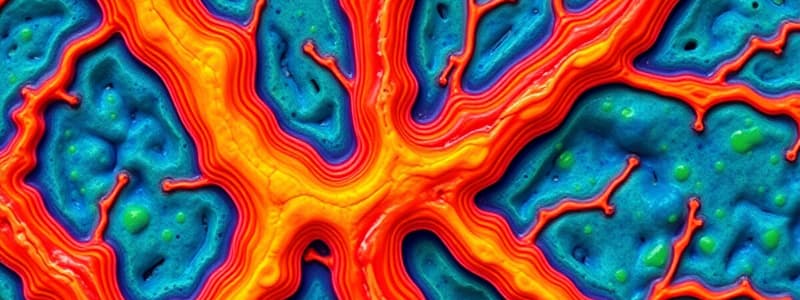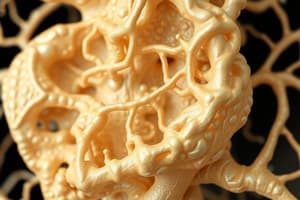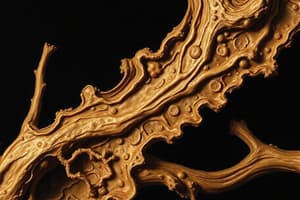Podcast
Questions and Answers
Which of the following is NOT a defining characteristic of hyaline cartilage?
Which of the following is NOT a defining characteristic of hyaline cartilage?
- Basophilic matrix
- Presence of Type II collagen
- Ability to undergo interstitial growth
- Presence of blood vessels (correct)
What specific process is responsible for the growth of hyaline cartilage, particularly through the formation of isogenic groups?
What specific process is responsible for the growth of hyaline cartilage, particularly through the formation of isogenic groups?
- Interstitial Growth (correct)
- Intercalated Growth
- Axial Growth
- Appositional Growth
Besides containing Type II collagen, what other components are primarily found within the matrix of hyaline cartilage?
Besides containing Type II collagen, what other components are primarily found within the matrix of hyaline cartilage?
- Elastin fibers and ground substance
- Collagen fibers and proteoglycans (correct)
- Reticular fibers and chondronectin
- Collagen fibers and fibronectin
Which of the following structures is primarily composed of elastic cartilage?
Which of the following structures is primarily composed of elastic cartilage?
What is the approximate percentage of Type II collagen by weight within the matrix of hyaline cartilage?
What is the approximate percentage of Type II collagen by weight within the matrix of hyaline cartilage?
Which of the following statements accurately describes the role of chondronectin in cartilage?
Which of the following statements accurately describes the role of chondronectin in cartilage?
What is the primary function of chondrocytes within the cartilage matrix?
What is the primary function of chondrocytes within the cartilage matrix?
Which component is primarily responsible for the high tensile strength and resistance to compressive forces found in cartilage?
Which component is primarily responsible for the high tensile strength and resistance to compressive forces found in cartilage?
What distinguishes axial isogenic groups of chondrocytes?
What distinguishes axial isogenic groups of chondrocytes?
Where does appositional growth of cartilage originate?
Where does appositional growth of cartilage originate?
Which type of collagen is predominantly found in the extracellular matrix of cartilage?
Which type of collagen is predominantly found in the extracellular matrix of cartilage?
What role do proteoglycans, such as aggrecan, play in the cartilage matrix?
What role do proteoglycans, such as aggrecan, play in the cartilage matrix?
Which statement accurately describes the relationship between the perichondrium and cartilage growth?
Which statement accurately describes the relationship between the perichondrium and cartilage growth?
What is a key characteristic of chondrocytes, as described in the text?
What is a key characteristic of chondrocytes, as described in the text?
Which of the following best describes the primary function of elastic fibers in the context of cartilage?
Which of the following best describes the primary function of elastic fibers in the context of cartilage?
In which of the following locations would you MOST likely find fibrocartilage?
In which of the following locations would you MOST likely find fibrocartilage?
What type of collagen is predominantly found in fibrocartilage?
What type of collagen is predominantly found in fibrocartilage?
Which characteristic is NOT associated with fibrocartilage?
Which characteristic is NOT associated with fibrocartilage?
What is the primary role of articular cartilage?
What is the primary role of articular cartilage?
Which of the following most accurately describes chondroblasts?
Which of the following most accurately describes chondroblasts?
What is the function of chondrogenic cells?
What is the function of chondrogenic cells?
The eosinophilic matrix of cartilage stains which color?
The eosinophilic matrix of cartilage stains which color?
Which function is LEAST associated with cartilage tissue in the body?
Which function is LEAST associated with cartilage tissue in the body?
What does the term 'perichondrium' refer to in the context of cartilage?
What does the term 'perichondrium' refer to in the context of cartilage?
Flashcards
Hyaline Cartilage
Hyaline Cartilage
The most common type of cartilage, found in areas like the nose, larynx, trachea, articular surfaces of joints, and the epiphyseal disc of growing bones.
Cartilage
Cartilage
A specialized connective tissue with a solid matrix composed mainly of collagen fibers and ground substances like proteoglycans.
Hyaline Cartilage Growth
Hyaline Cartilage Growth
It grows by interstitial growth through the formation of isogenic groups.
Elastic Cartilage
Elastic Cartilage
Signup and view all the flashcards
Cartilage Blood Supply
Cartilage Blood Supply
Signup and view all the flashcards
Elastic Cartilage Function
Elastic Cartilage Function
Signup and view all the flashcards
Elastic Cartilage Composition
Elastic Cartilage Composition
Signup and view all the flashcards
Elastic Cartilage Support
Elastic Cartilage Support
Signup and view all the flashcards
Chondroblasts
Chondroblasts
Signup and view all the flashcards
Fibrocartilage
Fibrocartilage
Signup and view all the flashcards
Eosinophilic Matrix
Eosinophilic Matrix
Signup and view all the flashcards
Perichondrium
Perichondrium
Signup and view all the flashcards
Chondrogenic Cells
Chondrogenic Cells
Signup and view all the flashcards
Articular Cartilage Function
Articular Cartilage Function
Signup and view all the flashcards
Chondrocytes
Chondrocytes
Signup and view all the flashcards
Lacunae
Lacunae
Signup and view all the flashcards
Extracellular Matrix
Extracellular Matrix
Signup and view all the flashcards
Type II Collagen
Type II Collagen
Signup and view all the flashcards
Proteoglycans
Proteoglycans
Signup and view all the flashcards
Appositional Growth
Appositional Growth
Signup and view all the flashcards
Axial Isogenic Groups
Axial Isogenic Groups
Signup and view all the flashcards
Interstitial growth
Interstitial growth
Signup and view all the flashcards
Isogenic groups
Isogenic groups
Signup and view all the flashcards
Chondronectin
Chondronectin
Signup and view all the flashcards
Chondrogenic layer
Chondrogenic layer
Signup and view all the flashcards
Fibrous layer
Fibrous layer
Signup and view all the flashcards
Avascular
Avascular
Signup and view all the flashcards
Study Notes
Cartilage Tissue Overview
- Specialized connective tissue with a firm matrix
- Provides support, cushioning, and absorbs forces
- Avascular, relies on diffusion for nutrients
- Contains collagen fibers and ground substances
- Crucial for structural support and friction reduction (e.g., joints)
Cartilage Components
- Cells:
- Chondroblasts: immature, actively produce matrix
- Chondrocytes: mature, reside in lacunae, maintain matrix
- Extracellular Matrix:
- Primarily Type II collagen
- Proteoglycans (e.g., aggrecan) provide consistency
- Glycoproteins (e.g., chondronectin) aid cell adhesion
Cartilage Growth
- Interstitial growth:
- Chondrocytes divide, creating isogenic groups
- Matrix is added within the cartilage
- Appositional growth:
- Matrix added from perichondrium
- Chondrocytes divide and differentiate from the perichondrium
Types of Cartilage
- Hyaline Cartilage:
- Most common type
- Found in nose, trachea, joints, etc.
- Contains Type II collagen (40% of weight)
- Matrix is basophilic (metachromatic)
- Elastic Cartilage:
- Found in areas requiring elasticity (e.g., ear)
- Rich in elastic fibers for flexibility
- Contains Type II collagen
- Fibrous Cartilage (Fibrocartilage):
- Found in areas with high stress (e.g., intervertebral discs)
- High tensile strength and resistance to compression
- Contains Type I and Type II collagen
- Eosinophilic matrix (stains pink)
- Lacks perichondrium
Perichondrium
- Dense irregular connective tissue
- Surrounds most cartilage types (except fibrous)
- Contains chondroblasts, aiding in growth
- Two zones:
- Closer to cartilage: contains chondroblasts
- Further from cartilage: contains chondrogenic cells
Studying That Suits You
Use AI to generate personalized quizzes and flashcards to suit your learning preferences.




